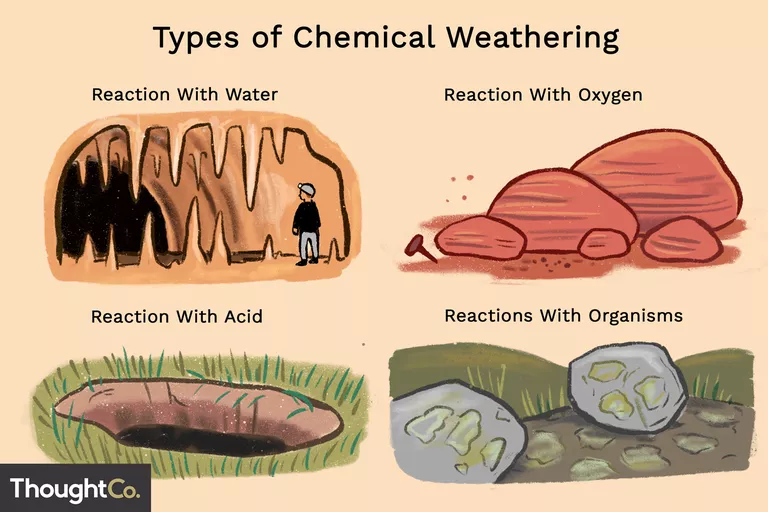Types of Chemical Weathering
INTRODUCTION
Did you ever wonder about the cause of rusting? It happens due to weathering. What is it? It is the breakdown or dissolution of rocks and minerals on the Earth’s surface. There are three types of weathering. These are- mechanical, chemical, and lastly, biological.
WHAT IS MECHANICAL WEATHERING?
Mechanical weathering happens due to external factors like rain, thawing, wind, freezing, sand, and other natural forces that hold power to alter rock physically.
WHAT IS BIOLOGICAL WEATHERING?
Plants and animals cause biological weathering as they tend to grow, burrow, and nest. And now, the core topic of this discussion is chemical weathering, of which the Statue of Liberty chemical weathering is a prime example of this.
THE DIFFERENT TYPES OF CHEMICAL WEATHERING
CHEMICAL WEATHERING DUE TO WATER
Water not only causes chemical weathering but mechanical too. The major difference? Mechanical weathering due to water happens when it drips or flows over rocks for a prolonged period; an example would be the Grand Canyon. Chemical weathering occurs when water dissolves minerals in rocks, resulting in new compounds. This is also known as hydrolysis.
An example would be when water comes in the proximity of granite. Feldspar crystals present inside the rock react chemically, forming clay minerals. Water also reacts with calcites in caves and causes dissolving. Calcite in dripping water is known to build up over several years and create stalagmites and stalactites.
OXYGEN IS THE REASON BEHIND CHEMICAL WEATHERING
Oxygen is a reactive element, and it reacts with rocks as per a phenomenon known as oxidation. Rust formation is a prime example of chemical weathering due to oxygen. Observe the Statue of Liberty before rusting and after rusting, and you will know the difference. In this weathering, oxygen reacts with iron, forming iron oxide. Rust is the reason behind the change in rock color, and iron oxide makes it more fragile.
CHEMICAL WEATHERING DUE TO ACID
When minerals and rocks get altered due to hydrolysis, they could produce acid. Acid is also produced when water undergoes reactions in the atmosphere, and acid rain is one example. When carbon dioxide mixes with water, a weak acid is produced. Calcite often dissolves due to this type of chemical weathering.
CHEMICAL WEATHERING DUE TO LIVING ORGANISMS
Here, living organisms grow, nest, and burrow; therefore, performing chemical reactions to acquire minerals from rocks and soils.
HOW WAS THE STATUE OF LIBERTY BEFORE CORROSION?
You have seen the Statue of Liberty in the picture and maybe in real life too, and by now, its blue-green color is an iconic combination. However, it was not always blue-green; when unveiled in 1886, the Statue of Liberty was a shiny brown color before turning green. However, the color changed because the outer layer of the statue is covered in hundreds of thin copper sheets, which reacted with air to form patina or verdigris, which protects the underlying metal. The three main components that form the patina would be:
- Cu₄SO₄(OH)₆ (green)
- Cu₂CO₃(OH)₂ (green)
- Cu₃(CO₃)₂(OH)₂ (blue)
CONCLUSION:
- Weathering is the breakdown or dissolving of rocks and minerals on the Earth’s surface.
- Weathering can be divided into mechanical, chemical, and biological.
- Chemical weathering happens when rocks undergo a complete chemical reaction resulting in new minerals.
FAQs:
1. Does the Statue of Liberty corrode?
Statue Of Liberty is an example of galvanic corrosion.
2. What happened to the copper on the Statue Of Liberty?
Copper reacts with air to form patina or verdigris, protecting the underlying metal.
We hope you enjoyed studying this lesson and learned something cool about Different Types Of Chemical Weathering! Join our Discord community to get any questions you may have answered and engage with other students like you! Don’t forget to download our app to experience our fun VR classrooms – we promise it makes studying much more fun! 😎
SOURCES:
- Examples of Chemical Weathering: https://www.thoughtco.com/examples-of-chemical-weathering-607608. Accessed 28 Feb 2022.
- Why Statue of Liberty is Green? https://www.thoughtco.com/why-statue-of-liberty-is-green-4114936. Accessed 28 Feb 2022.
- Preserving the Statue: https://www.ck12.org/c/chemistry/direct-redox-reactions/rwa/Preserving-the-Statue/. Accessed 28 Feb 2022.


